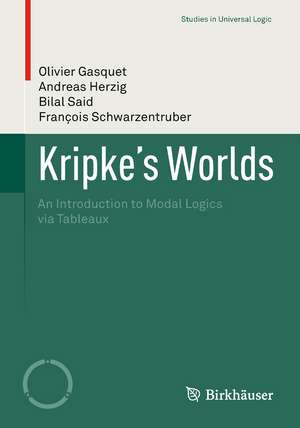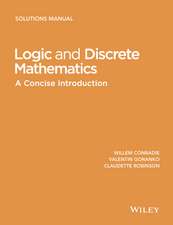Kripke’s Worlds: An Introduction to Modal Logics via Tableaux: Studies in Universal Logic
Autor Olivier Gasquet, Andreas Herzig, Bilal Said, François Schwarzentruberen Limba Engleză Paperback – 9 dec 2013
This book follows a more general approach by trying to build a graph, the advantage being that a graph is closer to a Kripke model than a tree. It provides a step-by-step introduction to possible worlds semantics (and by that to modal and other nonclassical logics) via the tableaux method. It is accompanied by a piece of software called LoTREC (www.irit.fr/Lotrec). LoTREC allows to check whether a given formula is true at a given world of a given model and to check whether a given formula is satisfiable in a given logic. The latter can be done immediately if the tableau system for that logic has already been implemented in LoTREC. If this is not yet the case LoTREC offers the possibility to implement a tableau system in a relatively easy way via a simple, graph-based, interactive language.
Din seria Studies in Universal Logic
-
 Preț: 454.16 lei
Preț: 454.16 lei - 17%
 Preț: 365.02 lei
Preț: 365.02 lei -
 Preț: 386.81 lei
Preț: 386.81 lei - 15%
 Preț: 653.14 lei
Preț: 653.14 lei -
 Preț: 399.29 lei
Preț: 399.29 lei -
 Preț: 397.38 lei
Preț: 397.38 lei - 15%
 Preț: 638.43 lei
Preț: 638.43 lei - 15%
 Preț: 643.99 lei
Preț: 643.99 lei -
 Preț: 395.85 lei
Preț: 395.85 lei -
 Preț: 406.05 lei
Preț: 406.05 lei -
 Preț: 384.09 lei
Preț: 384.09 lei -
 Preț: 389.11 lei
Preț: 389.11 lei - 15%
 Preț: 532.23 lei
Preț: 532.23 lei - 24%
 Preț: 802.17 lei
Preț: 802.17 lei - 15%
 Preț: 588.18 lei
Preț: 588.18 lei - 15%
 Preț: 592.12 lei
Preț: 592.12 lei - 15%
 Preț: 697.32 lei
Preț: 697.32 lei - 18%
 Preț: 953.65 lei
Preț: 953.65 lei - 18%
 Preț: 1129.96 lei
Preț: 1129.96 lei - 15%
 Preț: 642.68 lei
Preț: 642.68 lei - 18%
 Preț: 782.10 lei
Preț: 782.10 lei - 18%
 Preț: 787.78 lei
Preț: 787.78 lei -
 Preț: 335.51 lei
Preț: 335.51 lei - 18%
 Preț: 1119.47 lei
Preț: 1119.47 lei
Preț: 581.47 lei
Preț vechi: 684.08 lei
-15% Nou
Puncte Express: 872
Preț estimativ în valută:
111.26€ • 116.17$ • 92.09£
111.26€ • 116.17$ • 92.09£
Carte tipărită la comandă
Livrare economică 04-18 aprilie
Preluare comenzi: 021 569.72.76
Specificații
ISBN-13: 9783764385033
ISBN-10: 3764385030
Pagini: 250
Ilustrații: XV, 198 p. 73 illus.
Dimensiuni: 168 x 240 x 15 mm
Greutate: 0.35 kg
Ediția:2014
Editura: Springer
Colecția Birkhäuser
Seria Studies in Universal Logic
Locul publicării:Basel, Switzerland
ISBN-10: 3764385030
Pagini: 250
Ilustrații: XV, 198 p. 73 illus.
Dimensiuni: 168 x 240 x 15 mm
Greutate: 0.35 kg
Ediția:2014
Editura: Springer
Colecția Birkhäuser
Seria Studies in Universal Logic
Locul publicării:Basel, Switzerland
Public țintă
ResearchCuprins
Preface.- 1 Modelling things with graphs.- 2 Talking about graphs.- 3 The basics of the model construction method.- 4 Logics with simple constraints on models.- 5 Logics with transitive accessibility relations.- 6 Model Checking.- 7 Modal logics with transitive closure.- Bibliography.- Index.
Recenzii
From the reviews:
“This is an excellent book to use –– either as a stand-alone text or with another textbook –– for an introductory undergraduate course in logic addressed to majors in the humanities, social sciences, computer science, or mathematics. … A basic unifying theme of the book is to construct models of possible worlds and to check formula satisfiability using graph-theoretic tableaux systems.” (Russell Jay Hendel, MAA Reviews, February, 2014)
“This book provides an accessible introduction to modal logics indeed. … The book is well written and quite informative … . It can be used as an easy-going introduction for all who are interested in automated reasoning and need some formal tools for playing with modal logics.” (Andrzej Indrzejczak, zbMATH, Vol. 1280, 2014)
“This is an excellent book to use –– either as a stand-alone text or with another textbook –– for an introductory undergraduate course in logic addressed to majors in the humanities, social sciences, computer science, or mathematics. … A basic unifying theme of the book is to construct models of possible worlds and to check formula satisfiability using graph-theoretic tableaux systems.” (Russell Jay Hendel, MAA Reviews, February, 2014)
“This book provides an accessible introduction to modal logics indeed. … The book is well written and quite informative … . It can be used as an easy-going introduction for all who are interested in automated reasoning and need some formal tools for playing with modal logics.” (Andrzej Indrzejczak, zbMATH, Vol. 1280, 2014)
Textul de pe ultima copertă
Possible worlds models were introduced by Saul Kripke in the early 1960s. Basically, a possible worlds model is nothing but a graph with labelled nodes and labelled edges. Such graphs provide semantics for various modal logics (alethic, temporal, epistemic and doxastic, dynamic, deontic, description logics) and also turned out useful for other nonclassical logics (intuitionistic, conditional, several paraconsistent and relevant logics). All these logics have been studied intensively in philosophical and mathematical logic and in computer science, and have been applied increasingly in domains such as program semantics, artificial intelligence, and more recently in the semantic web. Additionally, all these logics were also studied proof theoretically. The proof systems for modal logics come in various styles: Hilbert style, natural deduction, sequents, and resolution. However, it is fair to say that the most uniform and most successful such systems are tableaux systems. Given a logic and a formula, they allow one to check whether there is a model in that logic. This basically amounts to trying to build a model for the formula by building a tree.
This book follows a more general approach by trying to build a graph, the advantage being that a graph is closer to a Kripke model than a tree. It provides a step-by-step introduction to possible worlds semantics (and by that to modal and other nonclassical logics) via the tableaux method. It is accompanied by a piece of software called LoTREC (www.irit.fr/Lotrec). LoTREC allows to check whether a given formula is true at a given world of a given model and to check whether a given formula is satisfiable in a given logic. The latter can be done immediately if the tableau system for that logic has already been implemented in LoTREC. If this is not yet the case LoTREC offers the possibility to implement a tableau system in a relatively easy way via a simple, graph-based, interactive language.
>dy>
This book follows a more general approach by trying to build a graph, the advantage being that a graph is closer to a Kripke model than a tree. It provides a step-by-step introduction to possible worlds semantics (and by that to modal and other nonclassical logics) via the tableaux method. It is accompanied by a piece of software called LoTREC (www.irit.fr/Lotrec). LoTREC allows to check whether a given formula is true at a given world of a given model and to check whether a given formula is satisfiable in a given logic. The latter can be done immediately if the tableau system for that logic has already been implemented in LoTREC. If this is not yet the case LoTREC offers the possibility to implement a tableau system in a relatively easy way via a simple, graph-based, interactive language.
>dy>
Caracteristici
Aims at filling the gap between existing introductory and advanced textbooks Introduces to the most important modal logics with multiple modalities from the perspective of the associated reasoning tasks Concentrates on the most general and powerful reasoning method for modal logics: tableaux systems Includes supplementary material: sn.pub/extras














